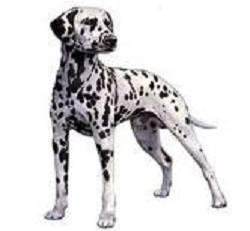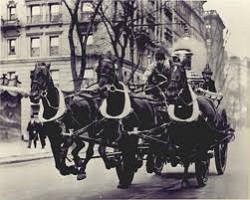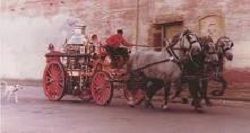How did that spotty black and white dog known as a Dalmatian come to be associated with firefighting? Dalmatians have been around for about 600 years. So, to understand how the Dalmatian became the number one firehouse mascot in England and the United States, we must take a long look back in history.
Weighing 25 to 55 pounds and standing 19 to 23 inches height, the Dalmatian was the perfect size to serve as a coach dog.
The Dalmatian is a very physical breed, with a strong, muscular body, and able to run great distances without tiring. The Dalmatian also has what seems to be a natural calming effect on horses. This trait about the breed was seen very early on, and soon the Dalmatian was identified with horses. Possibly horse mounted warriors or hunters first used the breed in their activities. During the 17th, 18th, and 19th centuries when the mode of travel was by horse or by carriage, the Dalmatians became a society dog, and trained to run alongside women’s carriages. They became knows as Coach dogs or Ladies dogs because of this. In fact, the term coaching is referring to how the Dalmatian will take up position just off the side and towards the rear of a horse and run with them.
In the 1700’s, Dalmatians were used to protect horses that pulled English stagecoaches. Typically two Dalmatians would run next to the horses as they pulled the coach. When other dogs tried to run out and scare the horses, the Dalmatian team would chase them away. Over the years, Dalmatians formed a close bond with horses.
During this time, horse theft was very common. Because of the potential for theft, Coach drivers would typically sleep in a hammock strung between two stalls where they would watch for thieves. However, because of the bond between the Dalmatians and the horses, the driver could sleep in a hotel or house if he owned a Dalmatian. Why? Because the Dalmatians would sleep with the horses and guard against horse theft.
It is during the era of horse drawn fire appartus that the Dalmatian becomes forever tied to the Fire Service. These fire house horses were required to spend hours at a time at a fire scene, or hours inside the fire house waiting for a call, and despite many misbeliefs, these fire house horses were not broken down old nags, but fine spirited horses. The Dalmatian became the horses pet as it were, to help keep them calm. There are many reports and stories of seeing a fire team rushing to the scene of a call, with a Dalmatian or two running between the horse teams.
Once on the scene of the call, the Dalmatian took over as guard dog, insuring that nothing was stolen from the apparatus. The Dalmatian is a very loyal breed to its owners, and an admirable foe when challenged. Because of the dog/horse bond, the Dalmatian easily adapted to the firehouse in the days of horse drawn fire wagons. Since every firehouse had a set of fast horses to pull the pumper, it became common for each group of firefighters to keep a Dalmatian in the firehouse to guard the firehouse and the horses. When the alarm came in, the Dalmatian led the way for the horse drawn pumper. In this way, the Dalmatian became the firefighters companion and a symbol of the fire service. Today, Dalmatians are still found in many firehouses in England, Canada, and the United States.
Because of this loyalty, the Dalmatian continued in the Fire Service once the horses were replaced with mechanical apparatus. Today, in many large cities, the Dalmatian is the guard dog of the fire truck while at the scene of fires and rescues. In its long history in the Fire Service, there are also reports of how the Dalmatian has rescued trapped firefighters or victims. Overall, the Dalmatian is a brave and valiant dog.





